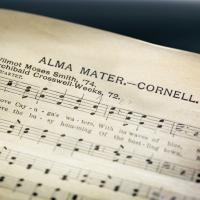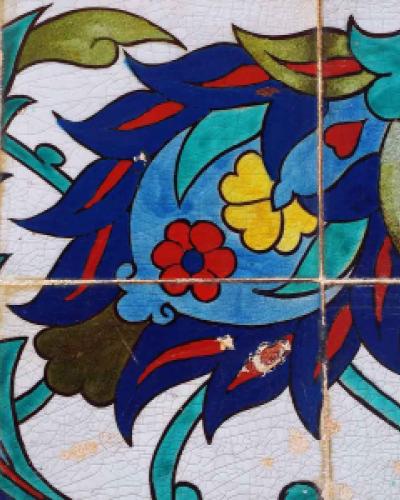Pre-enrollment begins on April 20, 2022. See our complete Fall 2022 course offerings.
We offer language instruction in Arabic, Hebrew, Persian and Turkish, all of which students can take to fulfill the College of Arts & Sciences language requirement. We also offer instruction in some of the ancient languages of the Middle East like Akkadian, Hieroglyphic Egyptian, Sumerian, Urdu and others.
NES 2610 and ANTHR/ARKEO 2010
3 credits. TR 1:00-2:15
The Near East is often defined by "firsts": the first cities, writing, and complex societies. Archaeology has long looked to the region for explanations of the origins of civilization. The Middle East has also long been a place where archaeology and politics are inextricably intertwined, from Europe's 19th century appropriation of the region's heritage, to the looting and destruction of antiquities in recent wars in Syria and Iraq. This introductory course moves between past and present. It offers a survey of 10,000 years of human history, from the appearance of farming villages to the dawn of imperialism, while also engaging current debates on the contemporary stakes of archaeology in the Middle East. Covering Iraq, Syria, Turkey, Iran, and the Caucasus, our focus is on past material worlds and the modern politics in which they are entangled.
Introduction to Islamic Civilization
NES 2655/HIST 2530/MEDVL 2655/RELST 2655
3 credits. MW 1:00-2:15
At the beginning of the 7th century, a new religion, Islam, appeared in Arabia and by the end of the century, Muslims had defeated the Byzantines and Persians and created an empire that stretched from Spain to India. For the next millennium, Islam glittered. Its caliphs, courts, and capitals were grander, more powerful, and more sophisticated than those of any medieval king, duke or prince. In this course, we will trace the emergence and development of Islamic civilization from the birth of Muhammad ca. 570 to the Mongol sack of Baghdad in 1258. We will read the Qur'an and listen to its recitation; examine the career of the Prophet Muhammad; follow the course of the Arab conquests; explore the nature of the conflict between Sunnis and Shi'is; learn about the five pillars of Islam, sharia law, theology, and Sufism; and assess the achievements of Muslim intellectuals in literature, art, architecture, science, and philosophy.
The History and Politics of Modern Egypt
NES 2670/ASRC 2670/GOVT 2673/HIST 2672
3 credits. MW 3:45-4:35 and a required discussion on Friday
This lecture class will explore the socio-cultural history of modern Egypt from the late 18th century to the 21st century "Arab Spring." We will explore Egyptian history under the Ottomans and the Mamluks, the unsuccessful French attempts to colonize Egypt, and the successful British occupation of the country. We will then examine the development of Egyptian nationalism from the end of the 19th century through Nasser's pan-Arabism to the 2011 Egyptian Revolution. We will accomplish this with the aid of a variety of texts and media, including novels and films.
Wondrous Literatures of the Near East
NES/COML/JWST/SHUM 2754
3 credits. TR 11:25-12:40
This course examines Near East's rich and diverse literary heritage. We will read a selection of influential and wondrous texts from ancient to modern times, spanning geographically from the Iberian peninsula to Iran. We will trace three major threads: myths of creation and destruction; travel narratives; and poetry of love and devotion. Together we will read and discuss such ancient works as the 'Epic of Gilgamesh' and 'The Song of Songs,' as well as selections from medieval works such as the 'Travels' of Ibn Battuta, the 'Shahnameh' of Ferdowsi, poetry of Yehuda HaLevi, and The Thousand and One Nights. The modern unit will include work by Egyptian Nobel Laureate, Naguib Mahfouz. Students will also have the opportunity to research and analyze primary source materials in the collections of Cornell Rare Books and Manuscript Collection, and the Johnson Art Museum. All material is in English translation.
NES 3535/RELST 3536
3 credits. TR 2:45-4:00
This course is an introduction to the religions of Iran from antiquity to the present. For over three millennia, Iran has been a hotbed and intercultural crossroads of religious activity as a result of its incredible ethnic and religious diversity, its many centuries of imperial rule, and its important geographical location between east and west. In this class, students survey the major religions of Iran, with an emphasis on those that originated there, including Zoroastrianism, Manichaeism, Mandaeism, Yezidism, and Bahaism. We will pay particularly close attention to the history of Zoroastrianism, one of the world’s oldest religions, whose adherents today, known as Parsis, reside mostly in India and Iran, and around the world. In addition to these native religions, students will also explore the impact that Iranian politics and culture have had on the presence of foreign religions in Iran, including on Judaism, Christianity, and Shi’ite Islam. Through a combination of lectures, secondary readings, and especially the close reading of primary sources in translation, students will not only gain a broad understanding of these religions, but also of Iranian history.
NES 3707/COML 3700/FGSS 3708/SHUM 3707/VISST 3707
3 credits. W 2:40-4:35
What does the representation of sexual encounter in the Arabian Nights (‘Alf layla-wa layla) have to do with a politics of race and gender? This course explores the millenia-long history of mediations and translations of this ancient Perso-Arabic text across literature, film, and popular culture, in the Middle East and in Europe. We will pay attention to the transmission of phobic tropes about female sexuality and miscegenation, or “interracial” sex as they manifest in various versions of 1001 Nights across time and space.
NES 4513/ANTHR 4013 and ANTHR 7013/NES 6513
3 credits. T 2:40-4:35
This course explores the implications and significance of using textual materials as anthropological evidence. While participant observation remains the cornerstone of ethnography, literary, archival, and other written works are increasingly being utilized as primary sources within the anthropological project. This course will hence offer an overview of anthropological works that trace the intersections between cultural production and the literary imagination. Rather than consider the literary elements of ethnography itself, we will strive to understand the disparate forms of social phenomena—both knowledge and practices—that arise from texts and textual practices specifically. Examples include analyses of literary cultures, media forms and non-traditional textual sources, bureaucratic structures, the use of archives, and more. Particular attention will be paid to works based in the Middle East and the Islamic world. By examining the different theoretical, political, and ethical considerations of using the written word as ethnographic evidence, we will be able to shed light on the anthropological project as a whole.
Mass Media and Identities in the Modern Middle East
NES 4666/HIST 4666 and NES 6666/HIST 6666
4 credits. W 12:25-2:20
This reading seminar will explore the expansion and influence of mass media in the Middle East from the late nineteenth to the turn of the twenty-first century. We will examine how the intersection of popular music, theater, poetry, film, and satellite television shaped culture, ideology, and identities in the modern Middle East. Topics we will consider include contested media representations of "modernity," gender, and evolving cultural, religious, national, and transnational identities. Although this seminar focuses upon the Middle East, it aims to locate the region within a larger global context.
Other NES courses of interest:
- Introduction to the Ottoman Empire
- Great Discoveries in Greek and Roman Archaeology
- Ancient Ships and Seafaring: Introduction to Nautical Archaeology
- Of Saints, Poets, and Revolutionaries: Medieval and Modern Iran and Central Asia





